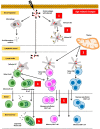Challenges in the Vaccination of the Elderly and Strategies for Improvement
- PMID: 37218912
- PMCID: PMC10204411
- DOI: 10.3390/pathophysiology30020014
Challenges in the Vaccination of the Elderly and Strategies for Improvement
Abstract
In recent years, the elderly has become a rapidly growing proportion of the world's population as life expectancy is extending. Immunosenescence and inflammaging contribute to the increased risk of chronic non-communicable and acute infectious diseases. Frailty is highly prevalent in the elderly and is associated with an impaired immune response, a higher propensity to infection, and a lower response to vaccines. Additionally, the presence of uncontrolled comorbid diseases in the elderly also contributes to sarcopenia and frailty. Vaccine-preventable diseases that threaten the elderly include influenza, pneumococcal infection, herpes zoster, and COVID-19, which contribute to significant disability-adjusted life years lost. Previous studies had shown that conventional vaccines only yielded suboptimal protection that wanes rapidly in a shorter time. This article reviews published papers on several vaccination strategies that were developed for the elderly to solve these problems: more immunogenic vaccine formulations using larger doses of antigen, stronger vaccine adjuvants, recombinant subunit or protein conjugated vaccines, newly developed mRNA vaccines, giving booster shots, and exploring alternative routes of administration. Included also are several publications on senolytic medications under investigation to boost the immune system and vaccine response in the elderly. With all those in regard, the currently recommended vaccines for the elderly are presented.
Keywords: comparative effectiveness analysis; elderly; frailty; immunosenescence; infection; recommended vaccine.
Conflict of interest statement
The authors declare no conflict of interest.
Figures



References
-
- He W., Goodkind D., Kowal P. An Aging World. United States Census Bureau; Washington, DC, USA: 2015.
-
- Aiello A., Farzaneh F., Candore G., Caruso C., Davinelli S., Gambino C.M., Ligotti M.E., Zareian N., Accardi G. Immunosenescence and its hallmarks: How to oppose aging strategically? A review of potential options for therapeutic intervention. Front. Immunol. 2019;10:2247. doi: 10.3389/fimmu.2019.02247. - DOI - PMC - PubMed
Publication types
LinkOut - more resources
Full Text Sources
